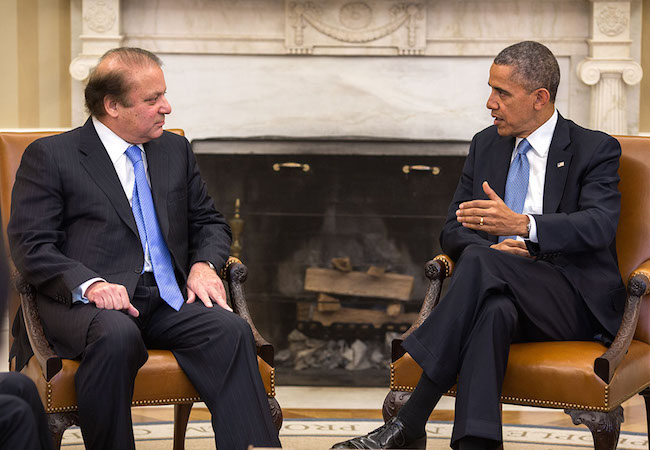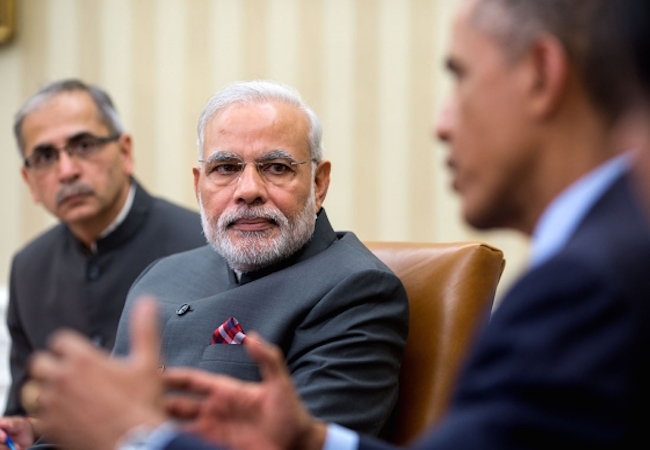Worth & betrayal: Managing the US strategic thinking in South Asia

By Syed Shahid Hussain Bukhari
Since its creation in 1947, Pakistan has been struggling to ensure its survival as an independent state. Pakistan was carved out of the British India, therefore, it was natural for remaining Indian forces to wish for reuniting India. In their surge for greater India, the governments in New Delhi never left any stone unturned to destabilize Pakistan. Due to its vulnerable position against India in the formative phase, Pakistan joined the US bloc during the Cold War by entering into western alliances like SEATO and CENTO. Both Pakistan and the US have been involved in various junctures from the Cold War to the War on Terror. Pakistan was the key ally in the US containment policy against the USSR and as a Non-NATO Ally in War on Terror against the Taliban. Pakistan has always been lauding the US due to the one and only objective; to deter or counter Indian aggression against its security. In sum, Pakistan’s threat perception is India centric. New Delhi’s strategic policies in the region have always been the central tenet of Pakistan’s foreign and strategic policies.
The current strategic environment in South Asia has drastically transformed where the US has now become the strategic partner of India and its policies toward Pakistan are routed through New Delhi. The policy makers in Washington D.C. are repeating the history what they had done after the Cold War. The pro-Indian set of mind has pronged the US intelligentsia as well that has lost its principles of objective analysis while producing their policy recommendations toward Pakistan. Commenting on the US obligations to help Pakistan in 1971, in a recent article against Pakistan, Christine Fair and Summit Ganguly argue that “In fact, even though sanctions imposed on both India and Pakistan after the 1965 war legally prohibited the United States from helping Pakistan when conflict with India reignited over East Pakistan in 1971, the Nixon administration nonetheless came to Islamabad’s assistance.” This argument about justifying the US defiance in 1971 can be refuted on the basis that under the rules of International Law, a state cannot enact such legislations which may prohibit her from fulfilling her internationally committed obligations rather states are supposed to adjust their municipal laws in accordance with their international obligations. Supposedly, we accept this argument; will United States allow India to refrain from its international obligations under the civilian nuclear cooperation agreement through amendment in Indian Laws, which may surpass all the obligations agreed bilaterally between the US and India under the framework of strategic partnership?
Another false claim is about Pakistan’s own interest in Afghanistan through Islamist militants in 1974 and pretends that the US had only joined in 1979. It needs to be assessed through a brief overview of the US containment policy given by George F. Kennan in 1946-47. The US had started its containment policy through the Truman Doctrine in 1947. As part of the US Policy of Containment, SEATO and CENTO were designed and Pakistan had joined them due to Indian inclination toward the USSR bloc with a so-called claim of non-alignment. The original puzzle for the US in 1971 was the India-USSR Treaty of Friendship signed in August 1971 prior to the Indian intervention in East Pakistan. It was actually the communist threat (Under the guise of India-USSR Treaty of Friendship 1971) that had deterred the US from helping Pakistan. The dismemberment of East Pakistan was, in fact, the Soviet success against the US who had refrained from fulfilling its legal as well as moral obligations to defend its ally.

Discussing the US non-proliferation concerns regarding Pakistan, Christine Fair and Summit Ganguly their self nullify their claim about the ‘Pakistan bringing the US Wallet in Afghanistan’ by stating that “Others in the White House and Congress, as well as those running the CIA’s covert operations in Afghanistan, maintained that Washington should continue to set aside its nonproliferation goals in favor of countering the Soviet threat in Afghanistan”. This statement manifests the US policy about proxy-war in Afghanistan. Since the US containment policy was formed in 1947, the US had been eager to counter Soviet dominance anywhere in the world from the Korean War to the Cuban Missile Crisis, Vietnam War and the Soviet invasion of Afghanistan until it got success through Pakistan’s assistance in collapse of the USSR. Pakistan’s importance in the current US drawdown in Afghanistan cannot be ignored or replaced with Indian presence. Ignoring Pakistan’s geographical significance and installing New Delhi in Kabul shall leave Afghanistan into another enigma.
The enactment of Pressler amendment 1985 in 1990 is also one of the examples about dubious US policies for Pakistan. Such amendments have always served the US national interest because they give the US President a loop to oversight his obligations in order to adjust the national security interests. The need for certification that was declined by George H.W. Bush in 1990, were later proved to be wrong when his son George W. Bush agreed to sell F-16s to Pakistan. It was again the US national interest which compelled them to oversight their non-proliferation concerns. Is it a coincident that the US sanctions are always enacted when they have no major interests with Pakistan? Sanctions have been one of the most efficient instruments of the US foreign policy not only with Pakistan but also with the rest of the world.
An advice to Obama Administration regarding ‘Pakistan’s misdeeds’ referring to the 2009 white paper on the US policy towards Pakistan is a typical expression of Indian thinking about Pakistan. Perhaps, Christine Fair and Summit Ganguly have overlooked Pakistan’s sacrifices for the sake of the US interests regarding terrorism. Pakistan has sacrificed more than any country in the world by joining the US war against terror and has been a real-time front line ally of the US that proved to be the first line of the US defense against terrorism. It is also noteworthy that Pakistan’s role in this regard has been acknowledged for several times by the US State Department as well as the US Secretary of State and the US President. The strategic demands of the contemporary South Asia has not changed yet. Pakistan is yet one of the major states that are pivotal to the US interests in the region, if managed properly. The current Obama Administration as well as the upcoming new US Administration in 2016 should not defy what Pakistan has been doing for the US and must not annoy it by repeating the same policy what it had adopted after the Cold war. The overwhelming US tilt towards India is one of the major concerns for Pakistan where it feels to be betrayed by the US administrations. Although, the US tilt towards India is aimed at to contain China, why can’t the US adopt a policy of engagement with China where Pakistan can be a better facilitator like it did in the past by bridging the diplomatic relations between the US and China? The US strategy to build India shall prove to be a counterproductive which shall induct intensity in the regional instability because of aggressive Indian ambitions as well as postures that can never be acceptable to both Pakistan and China. Pakistan’s strategic position is yet intact and cannot be over-sighted through the Indian lenses by the US policymakers. It shall not be in the US interest to adopt aggressive policies toward Pakistan as desired by India who has left its time-tested friendship with Russia and can later defy the United States as well.
Denying support to Pakistan’s military shall not be a good strategy due to military’s vital importance for the national security of the country along with mass-support by Pakistani public. The US refusal to replace or repair the already supplied strategic weapons shall do nothing with Pakistan’s defense capabilities rather would add fuel to already burning sentiments of Pakistani public towards the US. Moreover, Pakistan has now acquired the capability to fulfill such needs at home. Recent repair of AWACS aircraft by the Pakistani engineers, at half cost than American estimates, is the best example for the purpose. As it is evident that Pakistan has a well-established missile development program as well as nuclear weapon capability along with manufacturing of JF-17 Thunder fighter jets (supposed to be an alternate of F-16 for Pakistan), it shall be no more dependent on the US supplies in the near future. Despite the US efforts to stall Pakistan’s nuclear as well as missile development program, it could not avert Pakistan from achieving her national security objectives. The denial of military assistance to Pakistan shall also prove to be counterproductive because of the available potential market for the purpose around the world as well as the resilience of Pakistani nation to meet the challenges to their national security. Linking the US provided military equipment with a condition to use only against terrorism, is unrealistic. How is it possible to instruct your ally about the usage of provided weapons only to serve your interests but not in case of threat to his own security? Moreover, the US provided weapon systems are irrelevant in case of Pakistan’s national security imperatives regarding India. Pakistan’s security measures against India are not dependent on conventional arms provided by the US rather Pakistan meets the challenge of Indian aggression through nuclear deterrence. After the nuclearization of South Asia, the US military assistance to Pakistan has become less vital at the moment as it has been in the past.
The so-called posture of democratic partner (Democratic India) also needs to be evaluated. The US stance about democracy does not rest only on electoral system of democracy rather it is accompanied with the principles of human rights as well as protection to minorities and provision of social security at the doorsteps of the masses. Except holding elections in-time, no more requisite of a democratic nation can be found in India. At the moment, there are several freedom movements in India that aim at to save themselves from the gross-misconduct by the Indian governments. Absence of basic social services in the larger part of India, Human Rights violations in Kashmir and forced conversion of minorities into Hinduism are the modern-day evidences of so-called democratic posture of India, which is not, in any case, compatible with the US democratic values and therefore, not eligible to claim the democratic partnership with the United Staes.

Pakistan’s nuclear weapons are not meant for coercion to any country in the world except for India which is not a loop as well. It is a well known fact that Pakistan’s nuclear program is India centric and Pakistan has always developed its capabilities in reaction to Indian aggressive postures and doctrines. Pakistan’s nuclear facilities are under the best security arrangements in comparison with any country in the world that is acknowledged by the renowned people in the field as well. Suggesting air strikes on Pakistan’s nuclear facilities is an immature ambition that can never be materialized due to the competence of Pakistan’s armed forces to defend their homeland. The desires about non-intervention from the US in India-Pakistan crises shall also prove to be self-defeating for Indians because the US intervention has always benefited the New Delhi’s interests. Perhaps, New Delhi is yet hesitant to accept the reality of Pakistan’s defense capabilities and want to deliberately live in the fool’s paradise that they can overcome Pakistan through their aggressive postures. New Delhi must now come out of Utopia to subordinate Pakistan and learn to co-exist on equal footings. It is in the best interest of India to remain in peace with a Nuclear Pakistan. Undermining Pakistan’s capabilities and will to defend itself shall bring only suicidal outcomes. A stable and secure Pakistan is necessary for the region.




